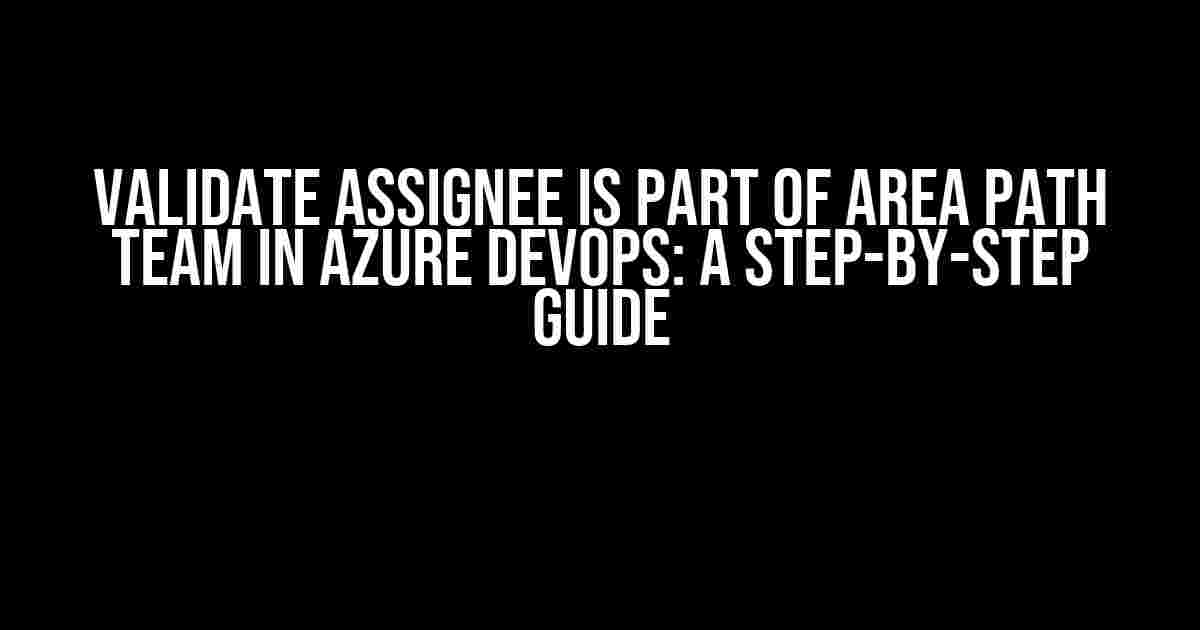As an Azure DevOps enthusiast, you’re probably familiar with the concept of area paths and teams. But have you ever wondered how to validate if an assignee is part of an area path team? Well, wonder no more! In this article, we’ll take you on a journey to explore the world of Azure DevOps and provide you with a step-by-step guide on how to validate assignees and their teams.
- What are Area Paths and Teams in Azure DevOps?
- Why Validate Assignee is Part of Area Path Team?
- Step-by-Step Guide to Validate Assignee is Part of Area Path Team
- Step 1: Create an Azure DevOps Organization and Project
- Step 2: Create Area Paths and Teams
- Step 3: Assign Team to Area Path
- Step 4: Create a Work Item and Assign it to a Team Member
- Step 5: Validate Assignee is Part of Area Path Team using Azure DevOps REST API
- Step 6: Validate Assignee is Part of Area Path Team using Azure DevOps CLI
- Conclusion
- FAQs
What are Area Paths and Teams in Azure DevOps?
Before we dive into the validation process, let’s take a quick peek at what area paths and teams are in Azure DevOps.
Area paths are a way to organize and categorize work items in Azure DevOps. They represent a hierarchical structure that helps teams and organizations to classify and filter work items based on their scope, functionality, or business area. Think of them as folders or categories that contain related work items.
Teams, on the other hand, are groups of people who work together to achieve a common goal. In Azure DevOps, teams are used to assign work items, track progress, and collaborate on projects. Teams can be assigned to area paths, which allows team members to focus on specific work items and areas of the project.
Why Validate Assignee is Part of Area Path Team?
Validating if an assignee is part of an area path team is crucial for several reasons:
- Work Item Assignment: Ensuring that the assignee is part of the area path team ensures that the work item is assigned to the correct person or team, thereby avoiding miscommunication and delays.
- Team Collaboration: Validation helps to ensure that team members are aligned with the project goals and objectives, promoting collaboration and reducing misunderstandings.
- Area Path Hierarchy: By validating the assignee’s team membership, you can maintain a clean and organized area path hierarchy, making it easier to track progress and identify dependencies.
Step-by-Step Guide to Validate Assignee is Part of Area Path Team
Now that we’ve covered the basics, let’s get to the good stuff! Here’s a step-by-step guide to validate if an assignee is part of an area path team:
Step 1: Create an Azure DevOps Organization and Project
If you haven’t already, create an Azure DevOps organization and project. This will serve as the foundation for our validation process.
https://dev.azure.com/{your-organization}/{your-project}Step 2: Create Area Paths and Teams
Create area paths and teams in your Azure DevOps project. For example, let’s create an area path called “My Area” and a team called “My Team”.
Area Path: My Area
Teams: My TeamStep 3: Assign Team to Area Path
Assign the “My Team” team to the “My Area” area path. This will create a hierarchical structure where the team is part of the area path.
Area Path: My Area
Teams: My Team (assigned)Step 4: Create a Work Item and Assign it to a Team Member
Create a new work item (e.g., a task or bug) and assign it to a team member. Let’s say we assign it to a user named “John Doe”.
Work Item: Task 1
Assignee: John Doe (My Team)Step 5: Validate Assignee is Part of Area Path Team using Azure DevOps REST API
Using the Azure DevOps REST API, we’ll validate if John Doe is part of the “My Team” team, which is assigned to the “My Area” area path.
GET https://dev.azure.com/{your-organization}/{your-project}/_apis/wit/wiql/{query}?api-version=6.0
Query: SELECT [System.Id], [System.Title], [System.AssignedTo], [System.AreaPath]
FROM WorkItems
WHERE [System.AssignedTo] = 'John Doe'
AND [System.AreaPath] UNDER 'My Area'
Response:
[
{
"id": 123,
"title": "Task 1",
"assignedTo": "John Doe",
"areaPath": "My Area\\My Sub Area"
}
]In the response, we can see that John Doe is part of the “My Team” team, which is assigned to the “My Area” area path.
Step 6: Validate Assignee is Part of Area Path Team using Azure DevOps CLI
Alternatively, we can use the Azure DevOps CLI to validate if John Doe is part of the “My Team” team, which is assigned to the “My Area” area path.
az devops wit query --org {your-organization} --project {your-project} --query "
SELECT [System.Id], [System.Title], [System.AssignedTo], [System.AreaPath]
FROM WorkItems
WHERE [System.AssignedTo] = 'John Doe'
AND [System.AreaPath] UNDER 'My Area'
"
Response:
[
{
"id": 123,
"title": "Task 1",
"assignedTo": "John Doe",
"areaPath": "My Area\\My Sub Area"
}
]Again, we can see that John Doe is part of the “My Team” team, which is assigned to the “My Area” area path.
Conclusion
Validating if an assignee is part of an area path team is an essential step in ensuring that work items are assigned correctly and team members are aligned with project goals. By following the steps outlined in this article, you can create a robust validation process using Azure DevOps REST API or CLI.
Remember to adapt this guide to your specific use case and requirements. With a solid understanding of area paths, teams, and validation, you’ll be well on your way to becoming an Azure DevOps master!
FAQs
Got questions? We’ve got answers!
| Question | Answer |
|---|---|
| How do I create an area path in Azure DevOps? | Go to your Azure DevOps project, navigate to the “Work” hub, and click on “Area Paths”. From there, you can create a new area path or edit an existing one. |
| How do I assign a team to an area path? | Go to your Azure DevOps project, navigate to the “Work” hub, and click on “Teams”. Select the team you want to assign and click on “Area Paths”. From there, you can assign the team to an area path. |
| Can I use Azure DevOps extensions to validate assignees? | Yes, you can use Azure DevOps extensions to validate assignees. For example, you can use the “Azure DevOps Work Item Validation” extension to create custom validation rules. |
We hope this article has been informative and helpful. Happy validating!
Frequently Asked Questions
Got questions about validating assignees in Azure DevOps? We’ve got answers!
Why do I need to validate assignees in Azure DevOps?
Validating assignees ensures that only authorized team members are assigned to tasks, preventing unauthorized access and ensuring data integrity within your organization.
How do I validate assignees in Azure DevOps?
You can validate assignees by checking if the assigned user is part of the area path team. This can be done through Azure DevOps’ built-in validation rules or by using custom scripts and APIs.
What happens if an assignee is not part of the area path team?
If an assignee is not part of the area path team, Azure DevOps will throw an error, preventing the task from being assigned to the unauthorized user. This ensures that only authorized personnel can access and work on tasks.
Can I customize the validation rules for assignees in Azure DevOps?
Yes, Azure DevOps allows you to customize validation rules for assignees through its extensibility features, such as custom scripts, APIs, and plugins. This enables you to tailor the validation process to your organization’s specific needs.
What are the benefits of validating assignees in Azure DevOps?
Validating assignees in Azure DevOps enhances security, reduces errors, and increases accountability within your organization. It also ensures that tasks are assigned to the right people, improving collaboration and workflow efficiency.


